Travels with Dick and Karen
London, Part 1
May 2016
Settling in & exploring
the local area
(the star on the map is where we're staying and the red line is the --very-- approximate path of the ramble)
|
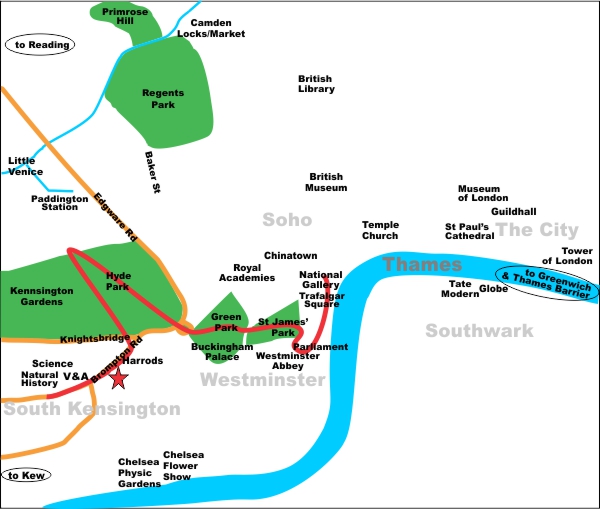 |
Why London? Two years ago we did an "everything but London" UK driving tour, vowing to come back someday for a month in London. After the Florida trip this spring Dick wanted a "non-driving" trip (which he then proceeded to negate by suggesting we tack on a stop in Iceland for 6 days).
The day we left Seattle Mt. Rainier came out to see us off.
(and our usual route to the airport was closed due to concerns about a tunneling machine going under it.. but traffic wasn't too bad) |
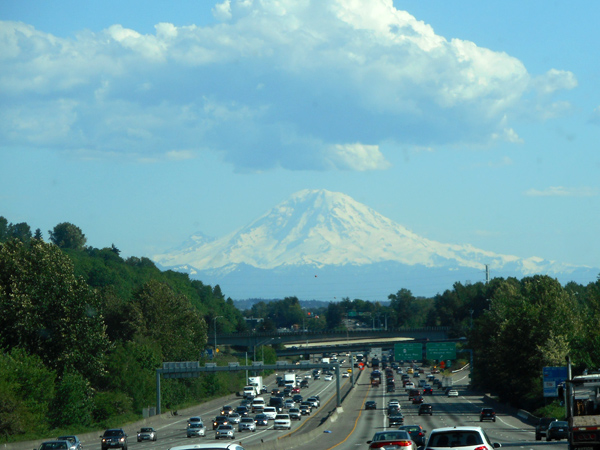 |
Delta had recently added this flight so the plane was almost empty... in coach. First and Business class were full. Coach folks could sleep on the unoccupied 3-wide center seats. We stayed at our usual window location. |
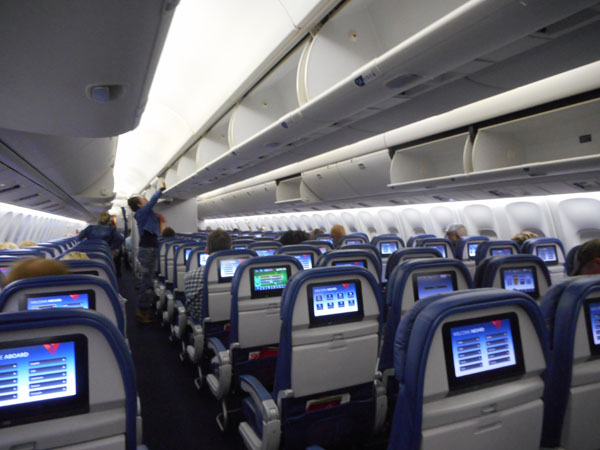 |
We could see the Thames Barrier flood defense from the air during landing (we saw it later from the water) |
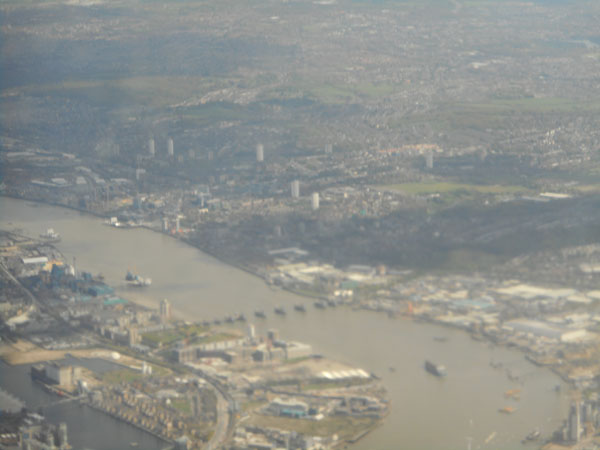 |
We rented a basement apartment ("flat") from Malcolm and Negat through VRBO. It was perfectly located on a quiet dead-end street and we recommend it highly.
It's a few doors away from Brompton Road, 2 blocks down from Harrod's. |
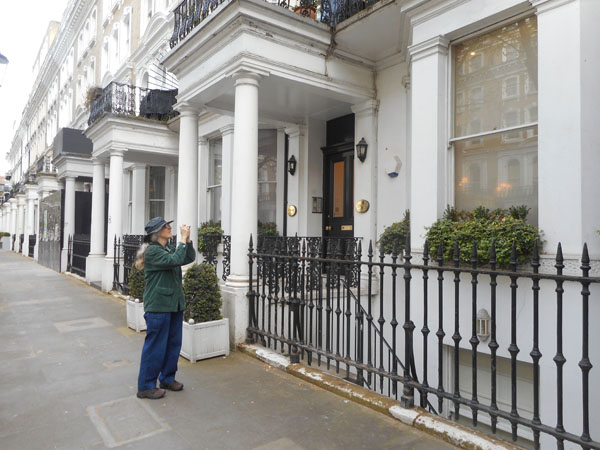 |
| We actually used the indoor stairs but this is "our" living room window and kitchen door/window. A gardener came through periodically to water the plants. |
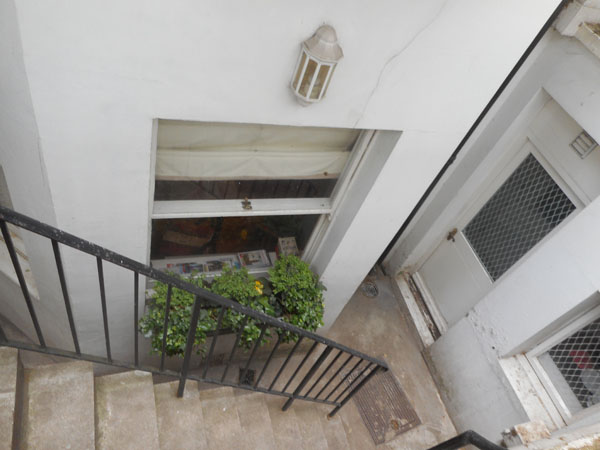 |
| A large room with a comfortable bed and sofa. |
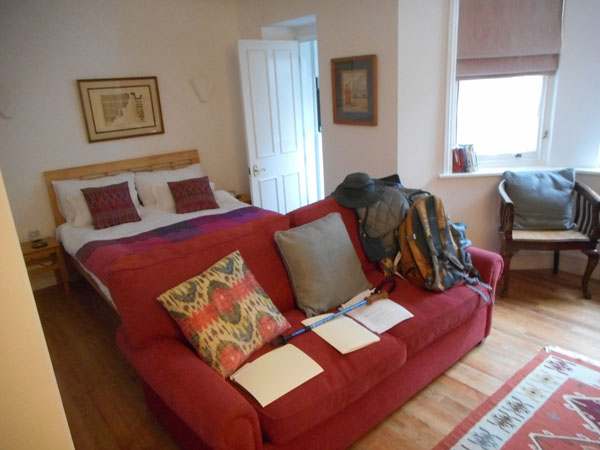 |
| An armoire to hang clothes and a small table for eating and planning. Even a selection of guidebooks. I think we turned on the TV once during our 4 week sojurn. |
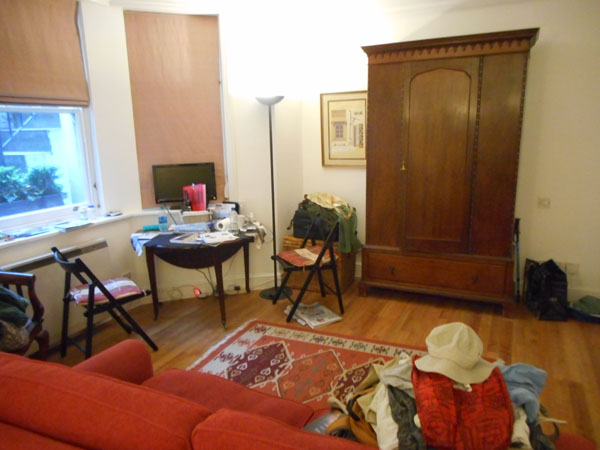 |
| The large bath was clean and well lighted. Karen had worried about mildew in a basement when we were considering this place but the quiet, always-on fan avoided the problem. |
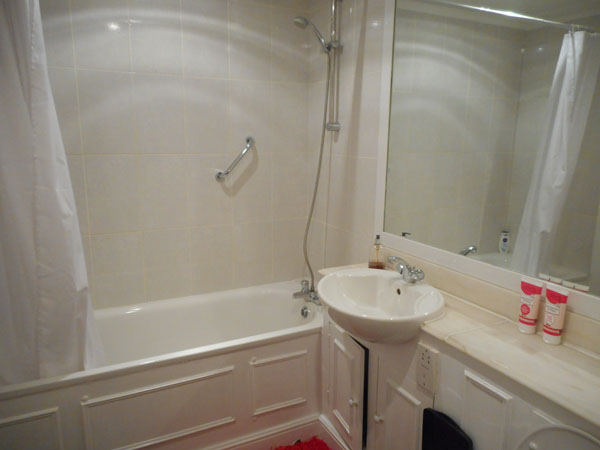 |
And it had a newly remodeled kitchen: refrigerator, oven, induction stove, microwave, sink, dishwasher and plenty of dishes and utensils. Even a clothes washer/sort-of-dryer in the cupboard below the stove. Quality digs! |
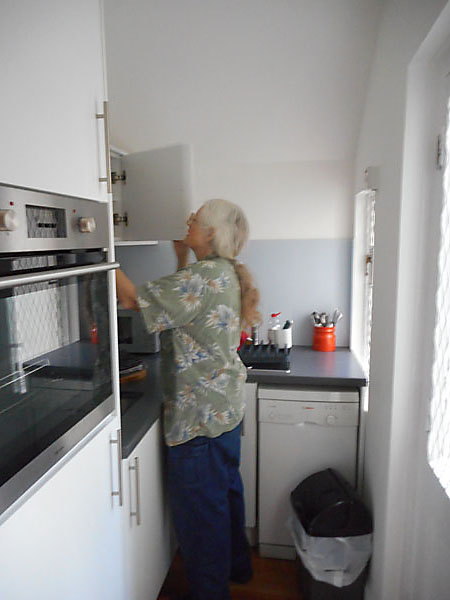 |
There are 3 small grocery stores within 2 blocks so we were all set up for breakfast. (yes, we drank bottled water: London water tastes "industrial". Drinking very much of it gave Karen problems). |
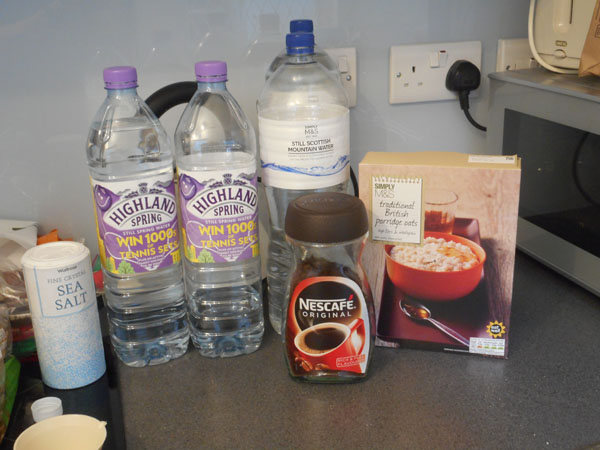 |
| The adjacent building was being gutted and rebuilt: note that you can see the sky through the windows. The building code requires that they retain the original Victorian façade. The containers seem to be offices and tool storage. Except for the couple of mornings we listened to the contractor's 8am cell phone discussions on the walk above our window, it wasn't very noticable. At worst the work served as an alarm clock. |
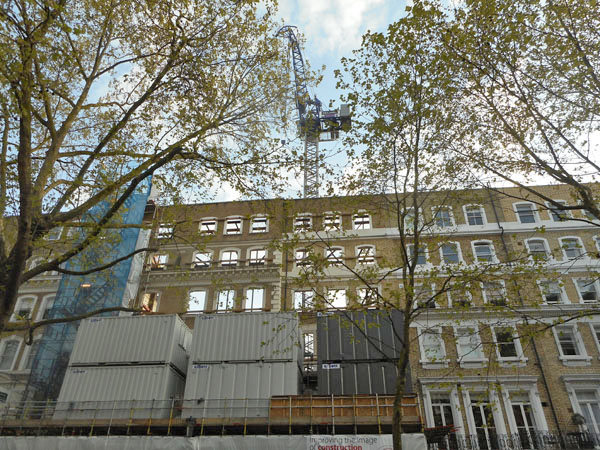 |
| The reason we picked this location is the 3 museums two blocks away: Here's the Victoria and Albert, one of Karen's favorite museums in the whole world. It presents arts and crafts through the ages, compared across cultures. Their presentations of the development of the tools and the techniques behind the work are very well done. |
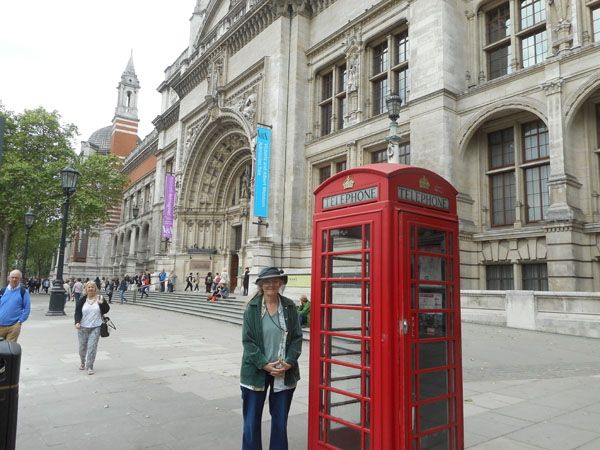 |
| In the lobby there's even a touch of Seattle: glass by artist Dale Chihuly. |
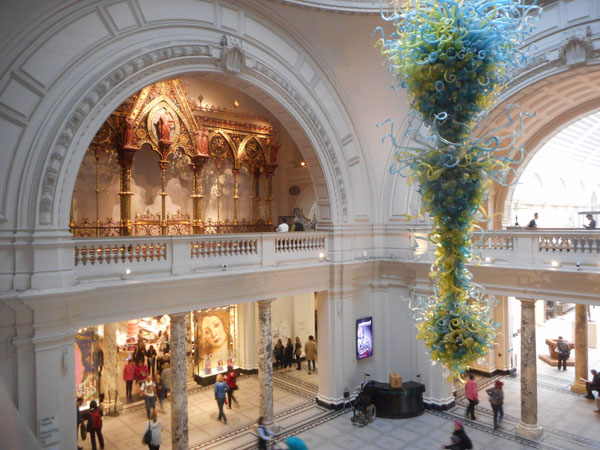 |
| The museum's central courtyard was getting a modern art installation that we watched progress through several visits. |
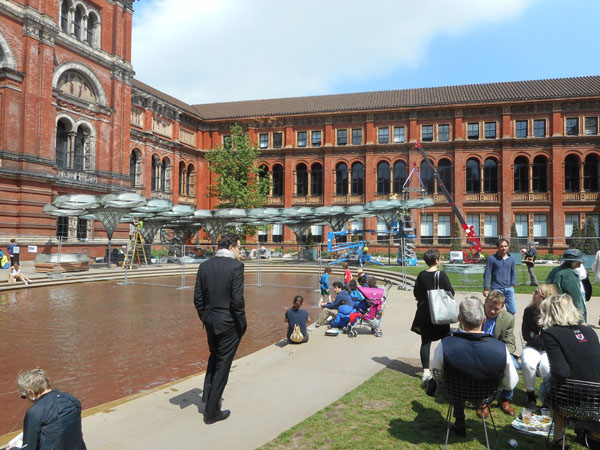 |
>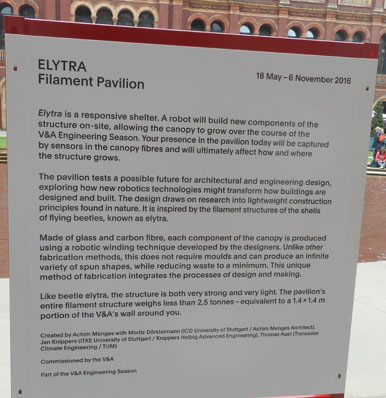
A robot arm will weave an example section when ready for viewing |
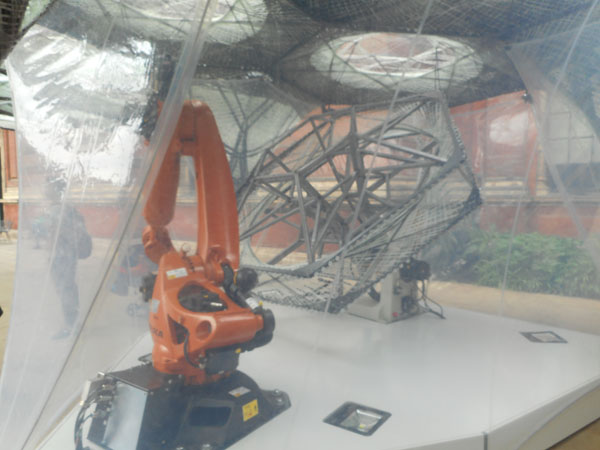 |
We usually lunched in the Museum d'jour. The V&A's food was served cafeteria-style in a hall, and then consumed in our choice of 3 very ornate rooms. For the rest of what we saw in the Victoria & Albert, see part 7. For now, we'll step back outside... |
 |
| Across "Exhibition Road" is the Natural History Museum. |
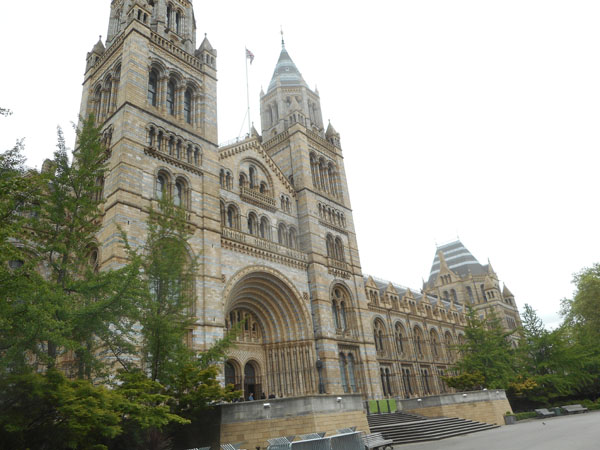 |
| With Dippy the Diplodocus occupying its iconic entry hall. Exhibits here are mostly geology and biology. |
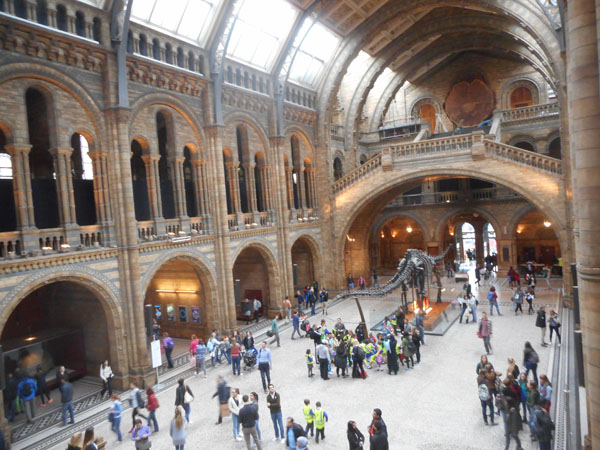 |
| Their poached salmon was very good, despite the definite step down in "dining room ambience" compared to the V&A. We probably had lunch here or at the V&A about half the trip. More from the Natural History Museum is also in part 7. |
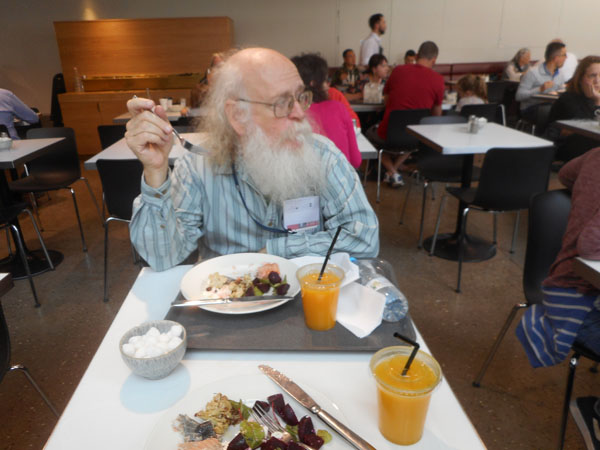 |
| And behind the Natural History museum is the Science Museum. Here's the line on Saturday morning (viewed from the V&A). We'd occasionaly choose which museum to visit based upon the length (or lack of) line. The V&A never had a line, except at the initial moment of opening the doors. |
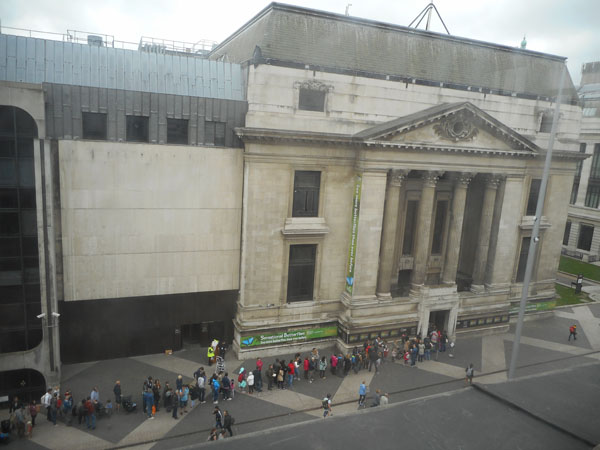 |
The Science Museum's door opens into a large hall of machines. There is a focus on technology from the last 2 centuries. There are some displays of more what we think of as science on the upper floors: an interactive exhibit on taste and cravings, one on energy, and one on the properties of materials. For a tour of this museum's collection of very large and very impressive and operating Victorian-era machinery (along with the small stuff), see part 7. |
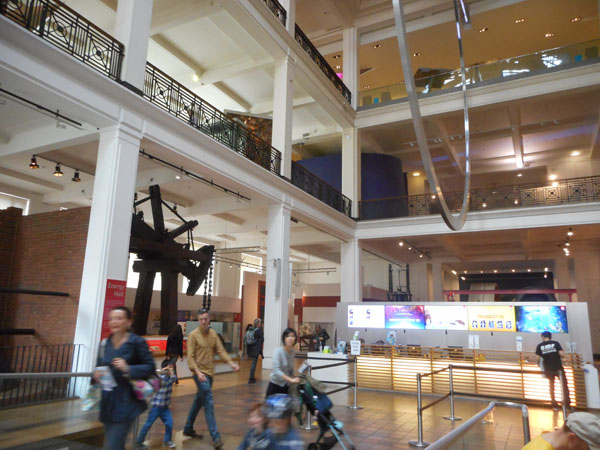 |
| Back out to Brompton Road. Two blocks east of the apartment is Harrod's department store. An early Sunday morning emptied the usually busy street. |
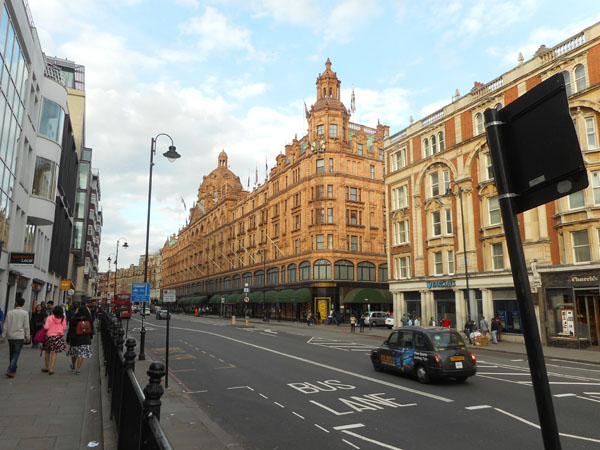 |
| Harrod's ornate interior more than met our expectations ... this is the "Egyptian Stairway". |
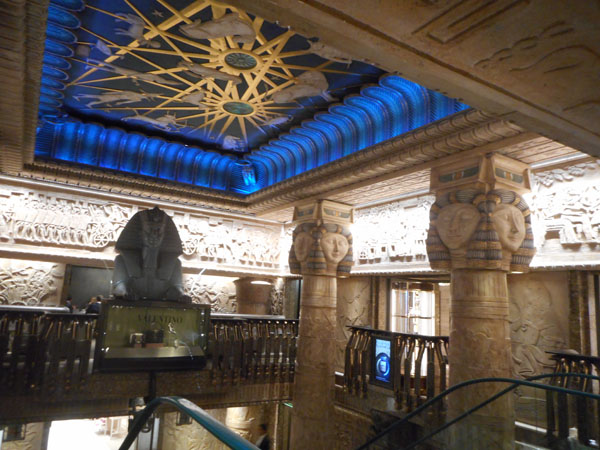 |
| The four "food halls" were amazing. An entire room devoted to chocolate (with one wall handling coffees). Another to meats and seafoods both domestic and international. Dozens of butchers and fishmongers to assist us. Another to pastries and breads. The ham and cheese croissants were better than many we had in Paris. We had never considered the possibility that Harrod's would become a repeat stop for "normal daily" foodstuffs. It did. |
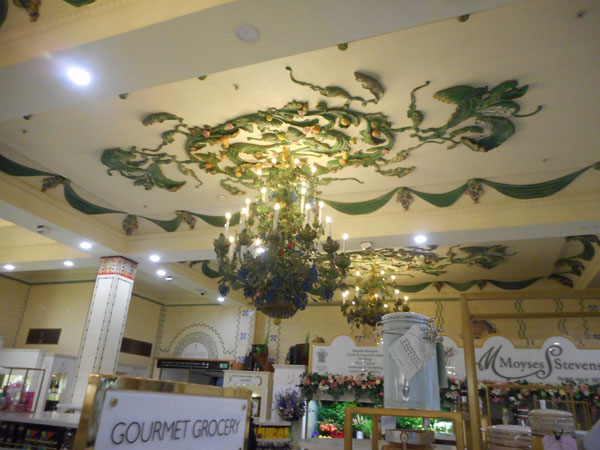 |
| We're normally tucked into bed by 9 pm, but one night we came back after 10 pm to find Harrod's very lit up. We'd bussed back from a delightful dinner at Negat, our hostess', apartment. |
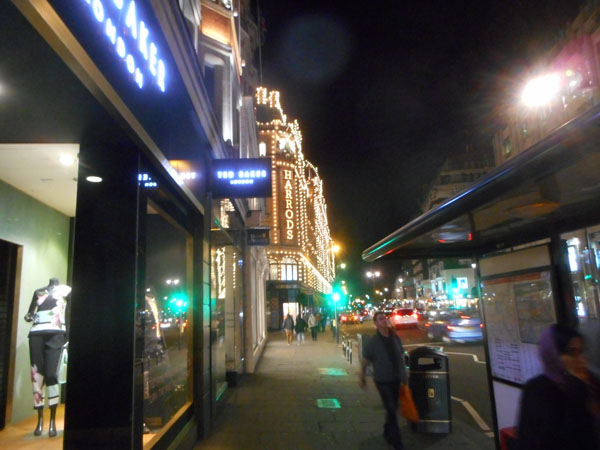 |
That encapsulates what we grew to call "home". What follows is about a 3 mile amble mostly eastward, assembled from several trips through the area. Our usual "outside" days typically racked up 10 to 12 miles (Karen carried a pedometer).
Residential streets would often surround small gardens. |
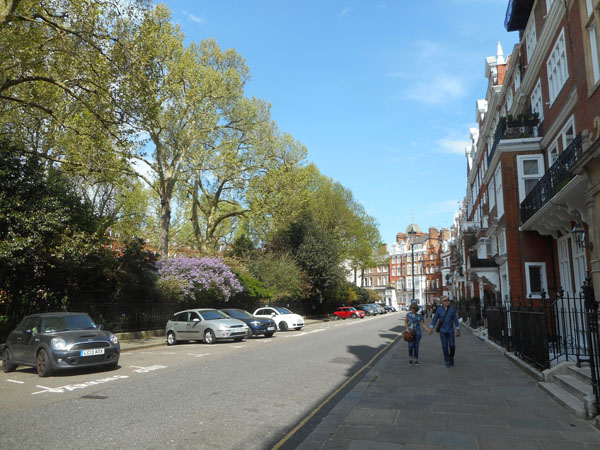 |
| Lovely to look at, but most are not for wandering through unless you are a member. |
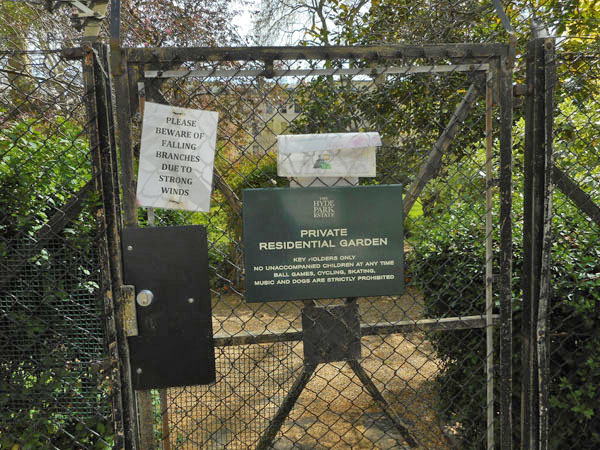 |
Peering through the fencing showed that these sites frequently took part in the British sport of ... |
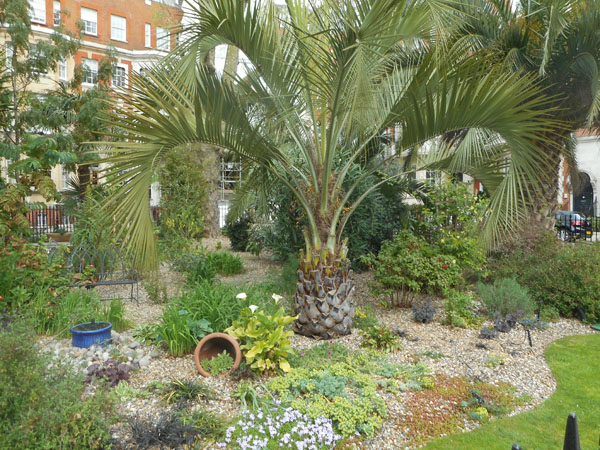 |
... competitive gardening. |
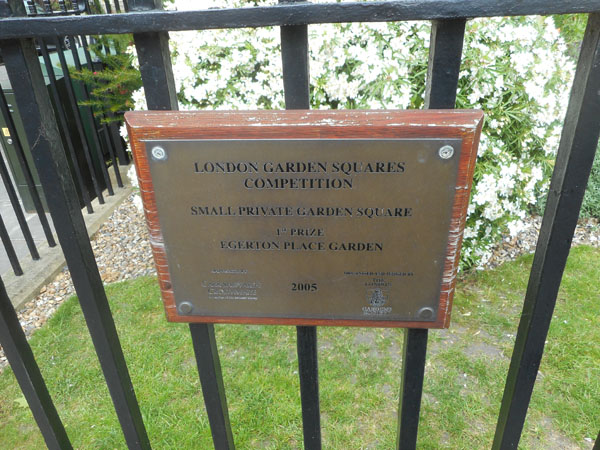 |
There are also a few "mile stones" scattered along the way. "London", as we know it, is really a melding of many smaller towns that were gradually engulfed by the central city's growth. The actual "City of London" is only about one square mile out of the current 600 square mile sprawl. Statuary Dragons (and acts of ritualized pagentry) still guard the City's boundaries. |
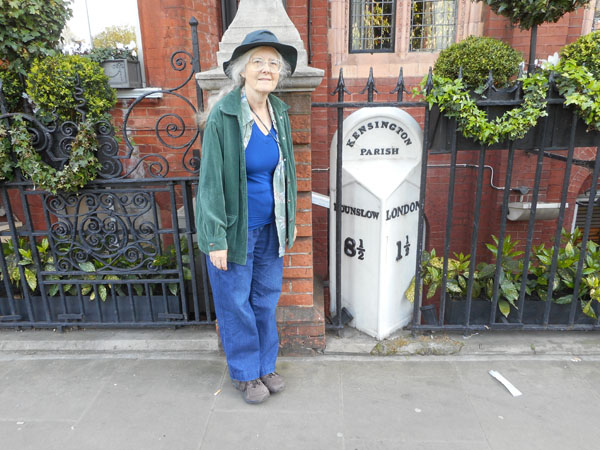 |
| Just north of the apartment (red star) is Hyde park ... |
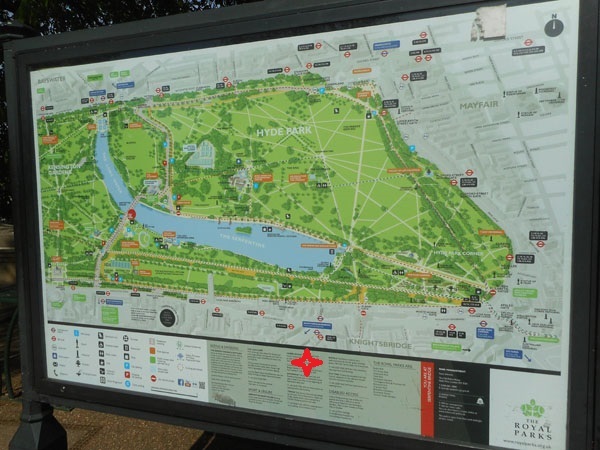 |
| A wide open space with benches and paths among trees. |
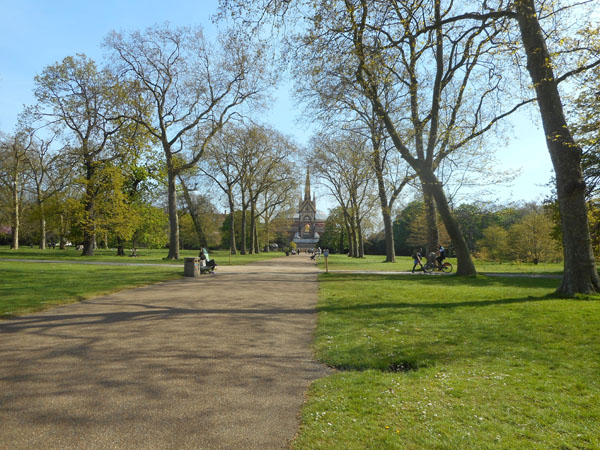 |
| Many are London Plane trees like this. Related digression: both of us were constantly getting things in our eyes and generally finding it dusty and having to blow our noses. One of the store clerks said it was the London Plane tree seeds. It seems they drop, get ground under foot, disintegrate and blow around at this time of year. |
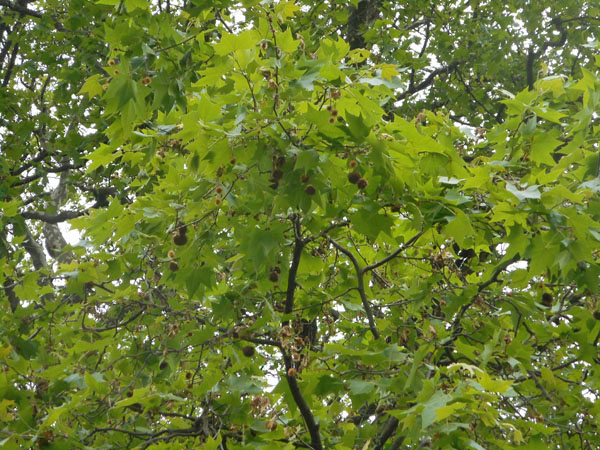 |
| But that might not be all of what was in the air. There was a broad hacking trail around the park. From the signage, a private stable nearby. |
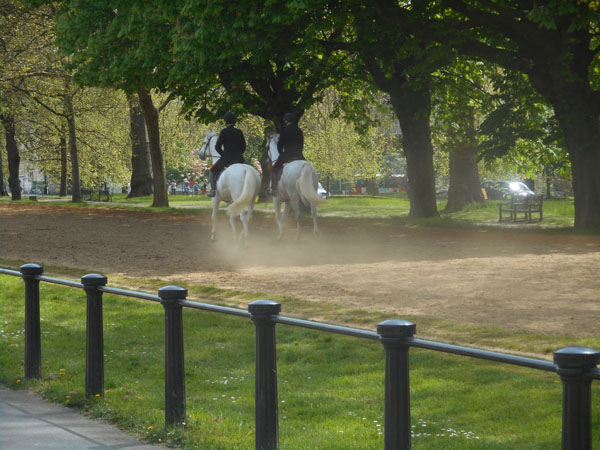 |
| Lots of statues |
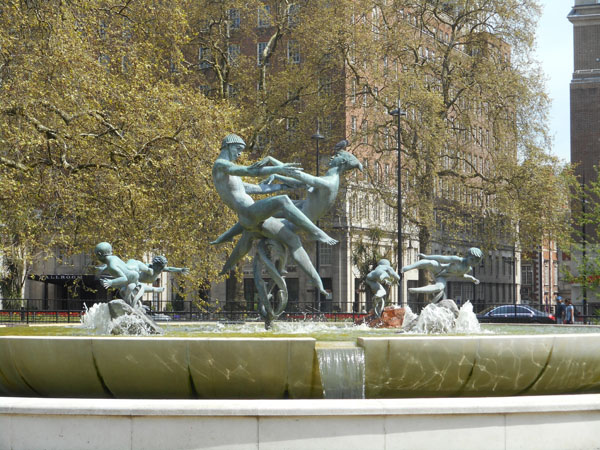 |
| |
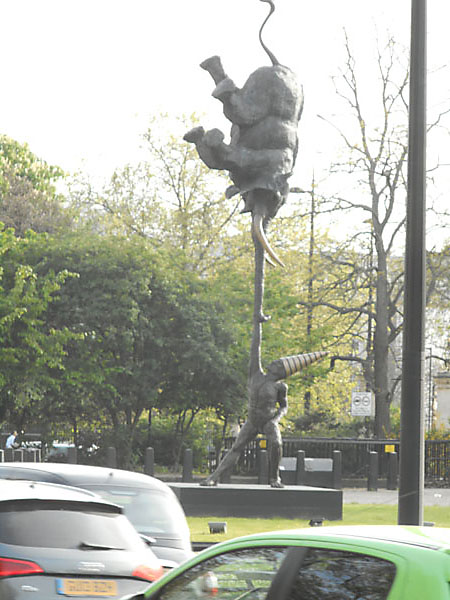 |
| This sculpture being worked on is also drinking fountain. |
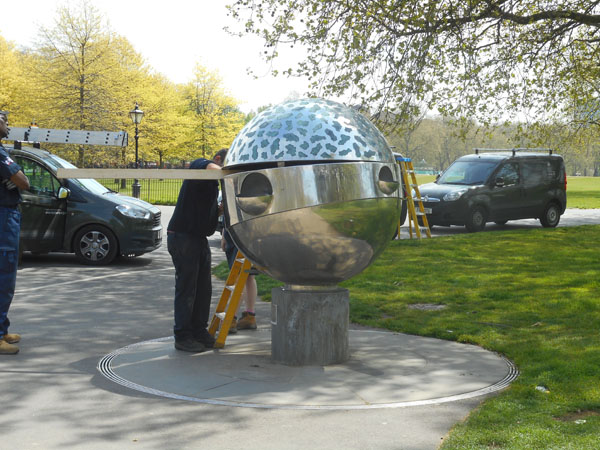 |
| Water features also abound: a long lake called the Serpentine runs through the park. It was filled with birds. |
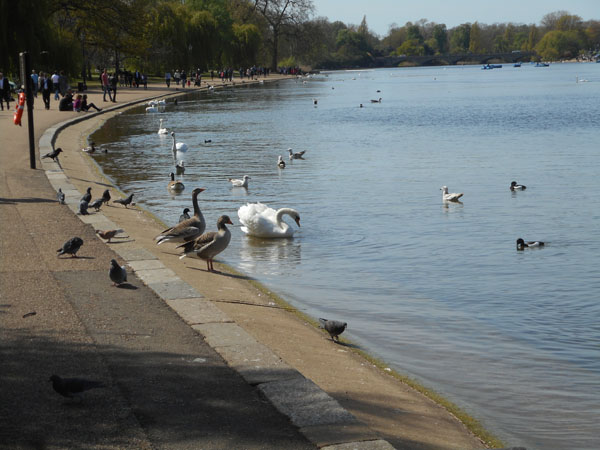 |
| The circular Princess Diana Memorial Fountain is delightful and full of playing children. |
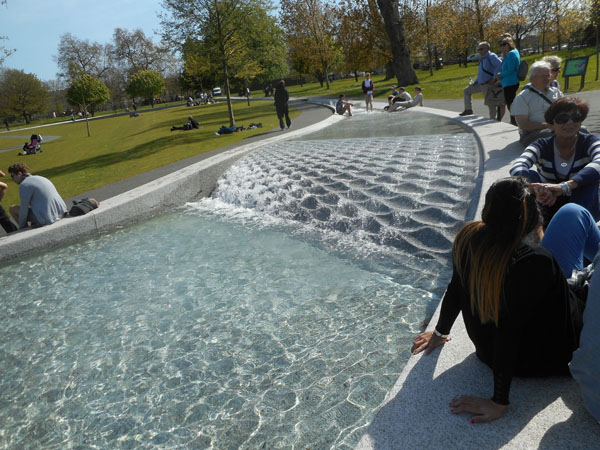 |
| Hyde Park's western edge abuts on to Kensington Gardens. On their southern edge is the Albert Memorial... |
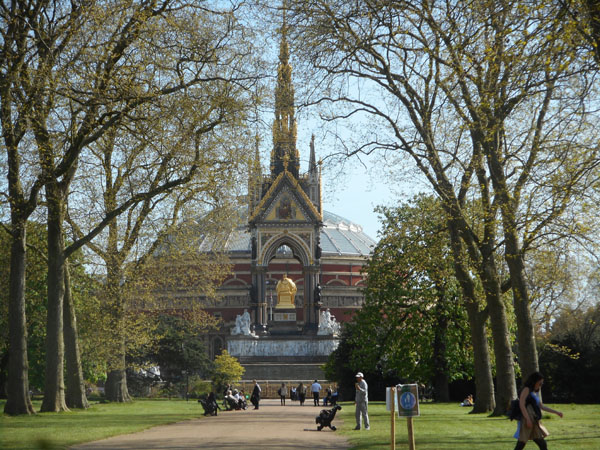 |
| ...and the Royal Albert Hall |
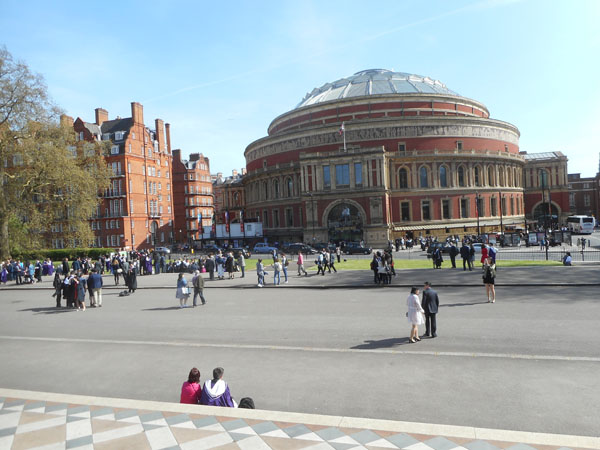 |
| The Italian gardens were pleasing in a more formal way. They're located at the north edge of Hyde Park at Lancaster Gate. |
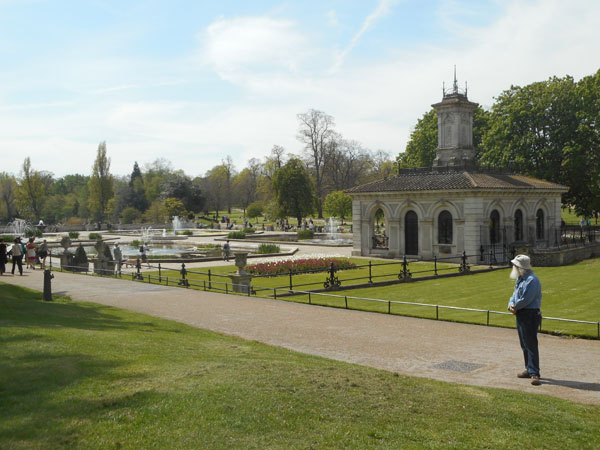 |
| We now exit Hyde Park's southeastern corner to reach Green Park. We missed seeing the changing of the guard but caught this unit of the Household Cavalry Mounted Regiment coming down from their Knightsbridge barracks towards Buckingham Palace. |
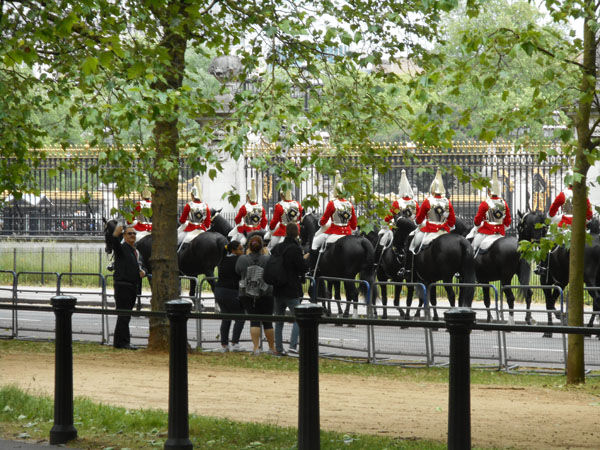 |
| The "Canada Gate" connects Green Park with the ... |
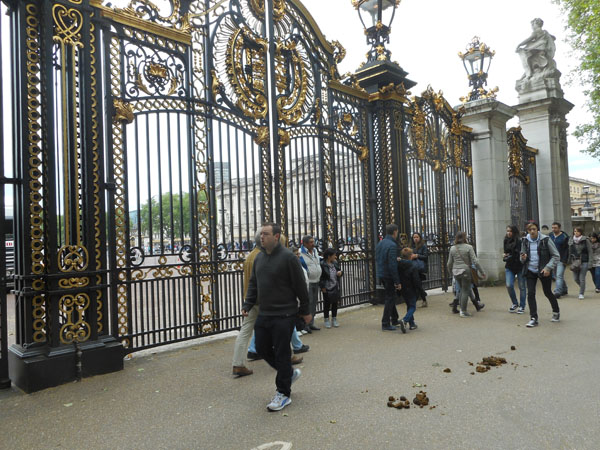 |
| the Queen Victoria Memorial and flowers, which stands in front of ... |
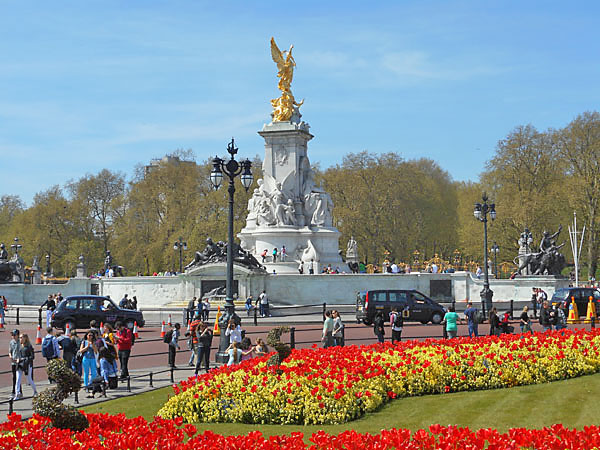 |
| Buckingham Palace. |
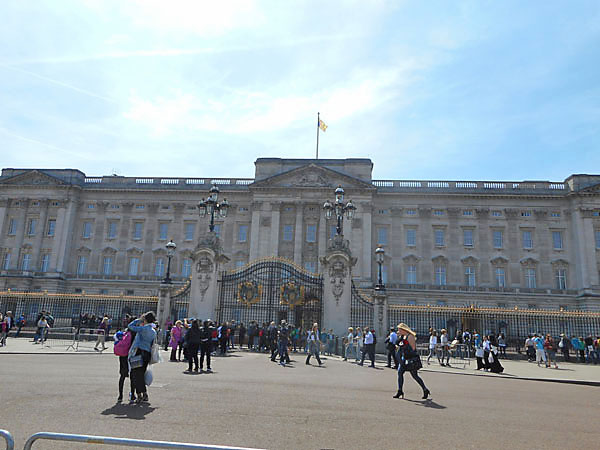 |
| ... with its pair of guards smartly marching to and fro. |
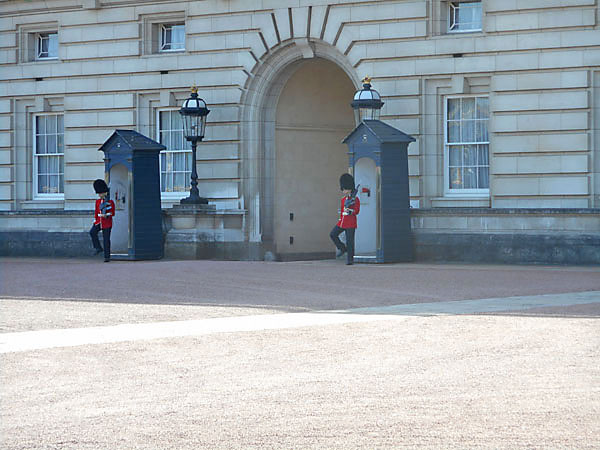 |
| On the flowered embankment leading to St James Park was a busking piper. |
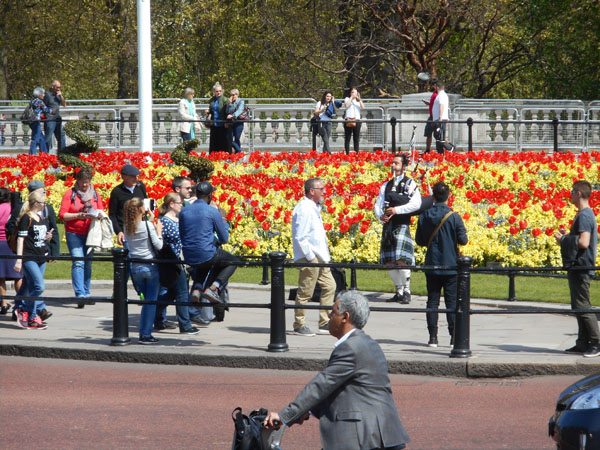 |
| A few tangled blocks due South of the palace is Westminster Cathedral (not to be confused with Westminster Abbey further east) |
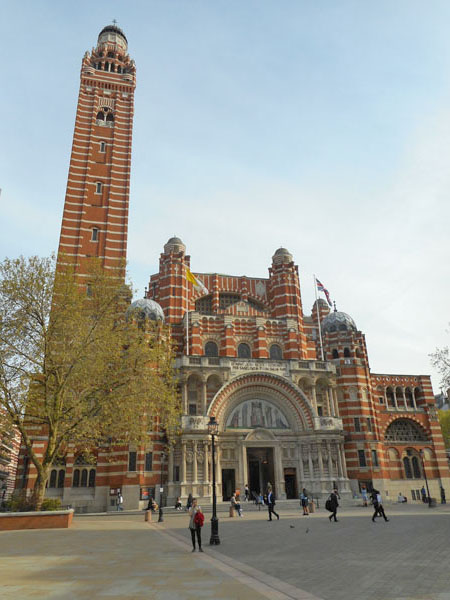 |
| Not all bulidings in the area are old (or what are actually reconstructed versions of the old buildings: this area was heavily bombed in World War II). This glass construction featured in a Sherlock episode. |
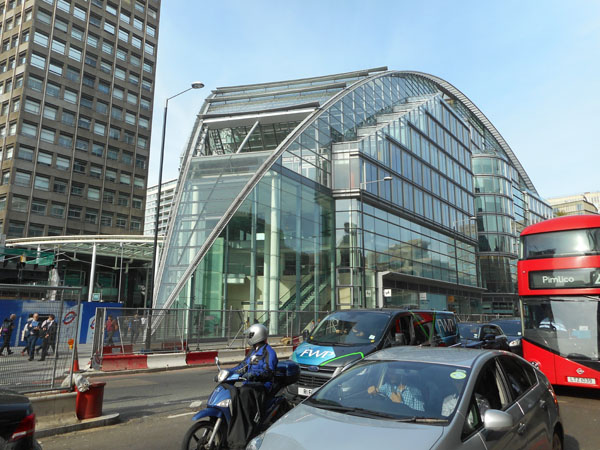 |
| Along with all the government buildings there are also many embassies in the area. We frequently played guess the flag. This is at one corner of Belegrave Square. |
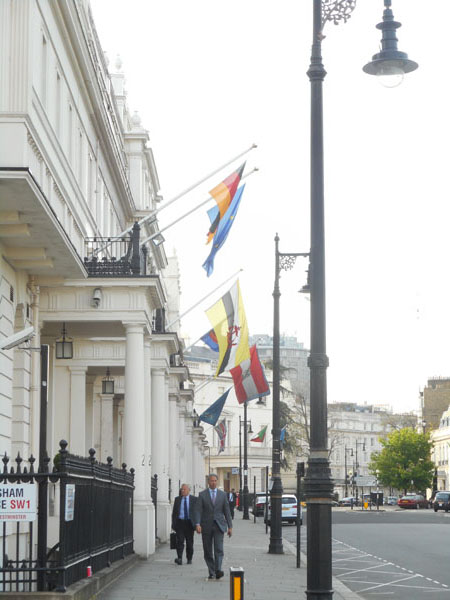 |
We came upon a pair of mounted soldiers flanking a gate:
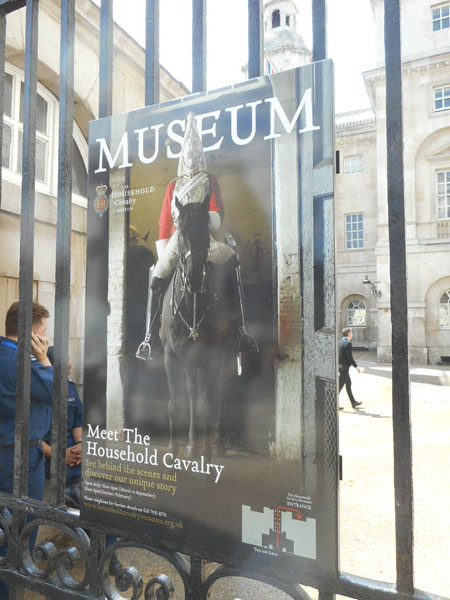
|
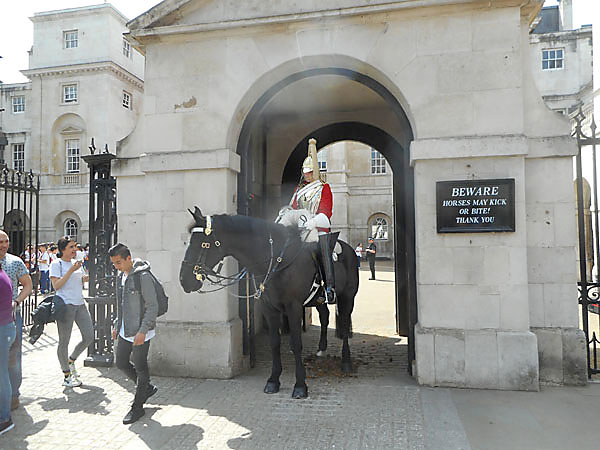 |
The Horse Guards Parade Ground was set up for a pagent:

|
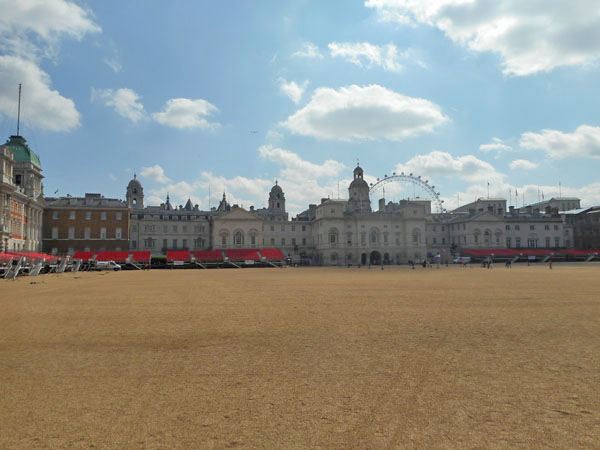 |
| Then we come to St. James Park. |
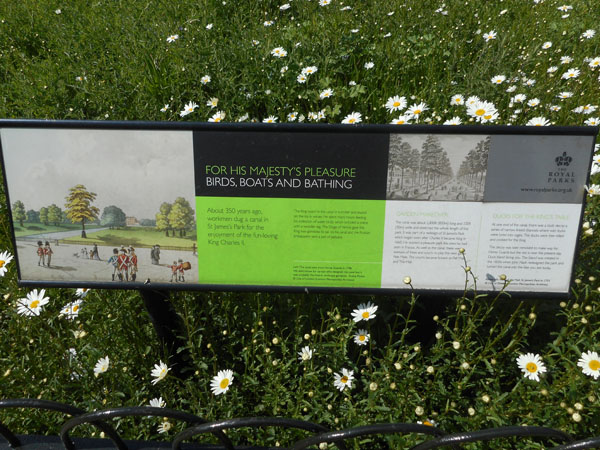 |
| lots of green, with flowers (note tree fern: Karen puts in photos of them whenever she finds them, please be patient with her affliction) |
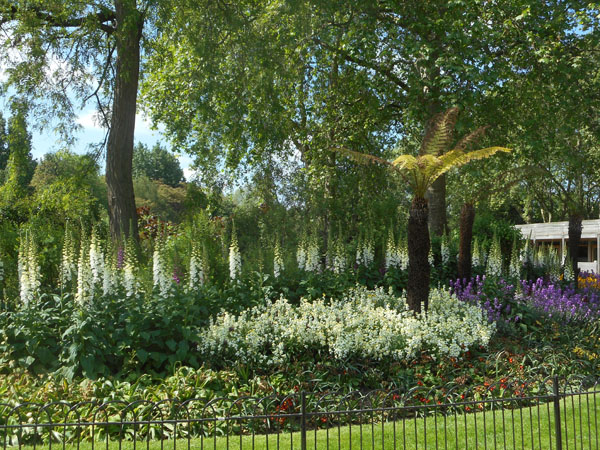 |
| benches and flowers |
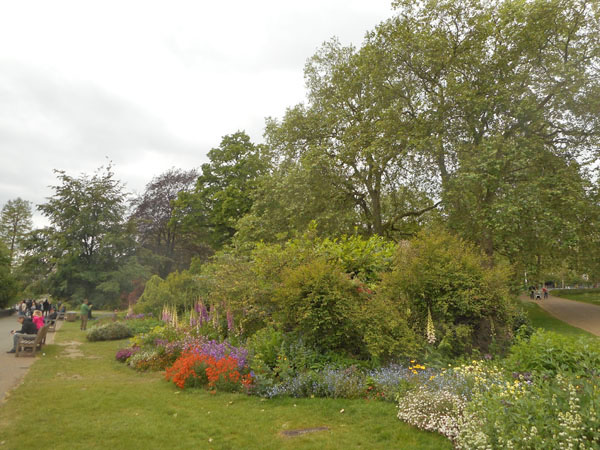 |
| and fountains (Buckingham Palace in the distance) |
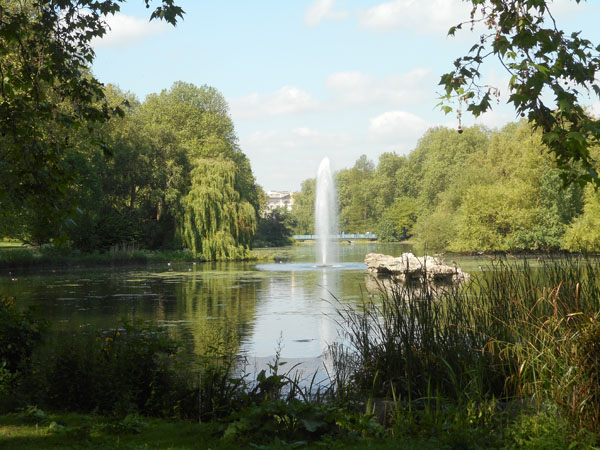 |
and known for its birds:
gray heron (slightly different from the blue heron of the Americas) |
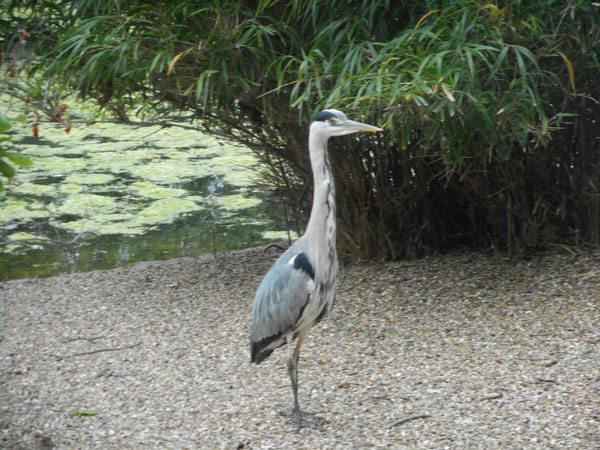 |
| Swans (with cygnet riding on the parent's back) |
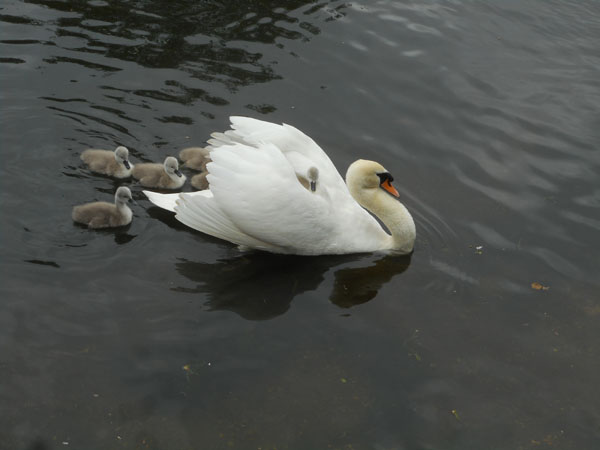 |
| nesting coots |
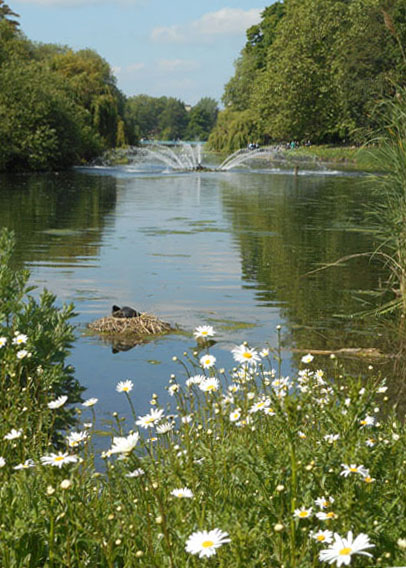 |
| And the usual herds of pigeons and ducks (we saw, but didn't get a photo of, the pelicans ... the originals were a gift from Russia in 1664, but the newest trio are recent arrivals from Prague (and wing-clipped). |
 |
| Sir John Franklin features in one of our favorite songs so we were pleased to spot this statue of him. |
 |
| Around the southeast corner of St James Park is Westminster Abbey |
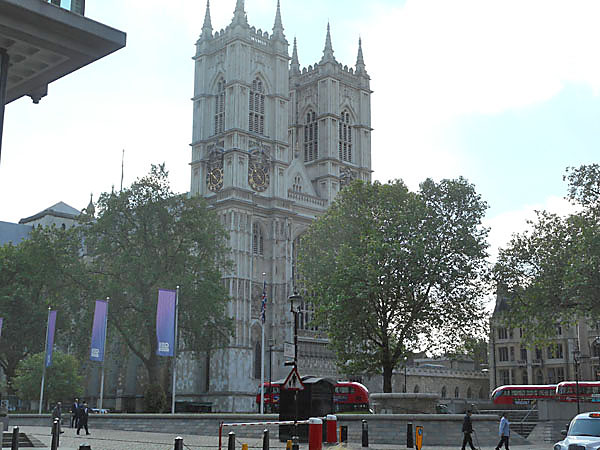 |
| |
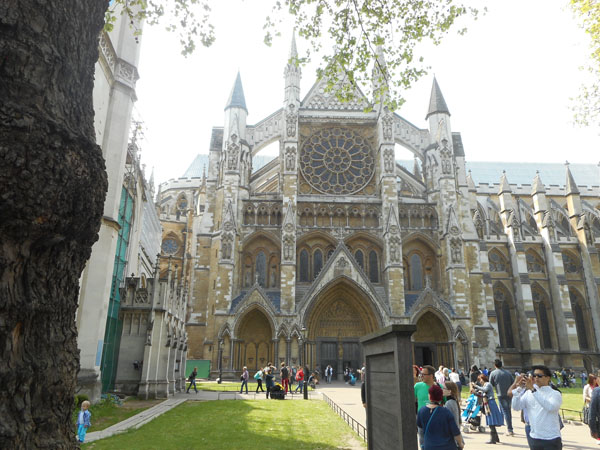 |
| You can't take photos in the church itself: it is the usual ornate edifice with many chapels, lots of memorials and over two hundred interred royalty, notables and clergy. |
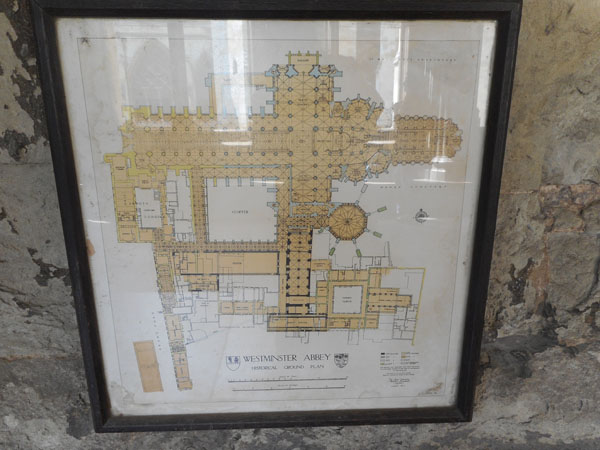 |
| The cloisters, with grave markers forming much of the floor |
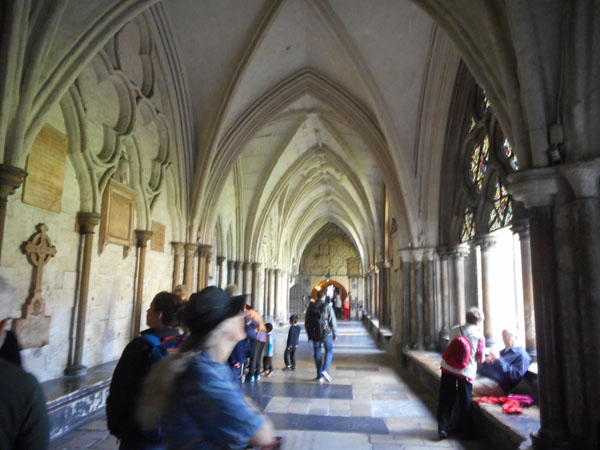 |
| |
 |
| And one of the chapels from when it was used as an abbey |
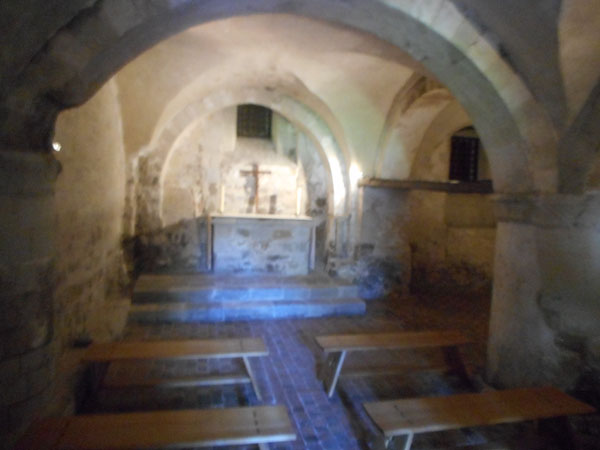 |
| Karen likes a culture that honors its plumbers as well as its soldiers |
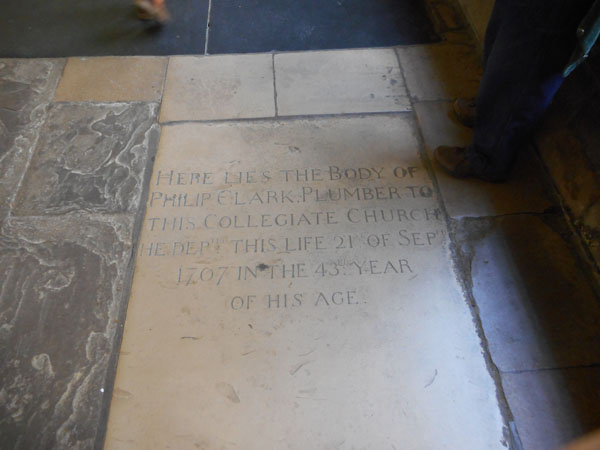 |
| scientists |
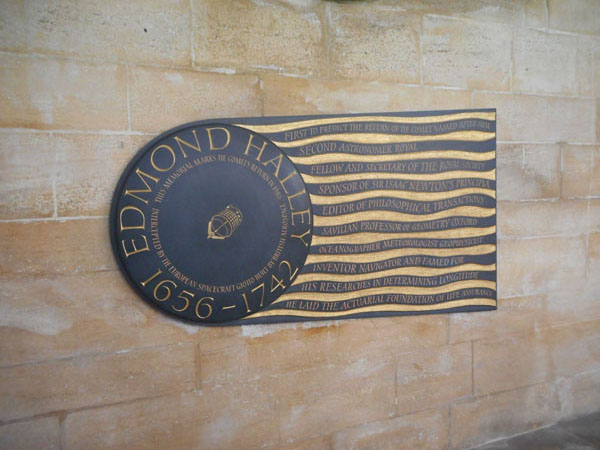 |
| and explorers |
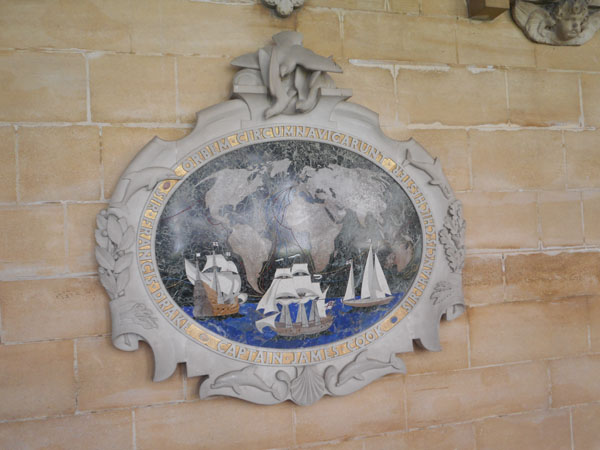 |
| Very old doors, one of which lead into a nice basement restaurant where we had lunch |
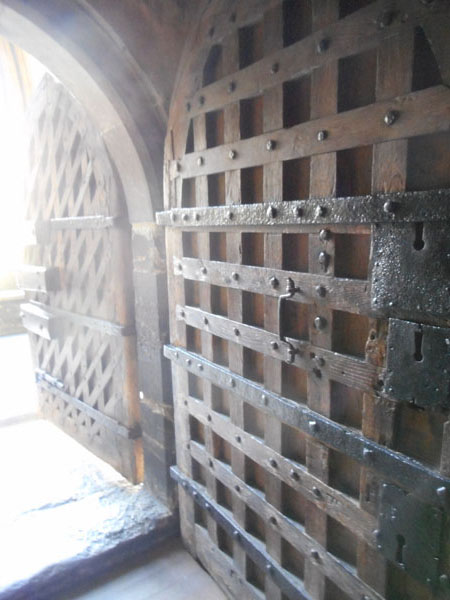 |
| very thick walls too |
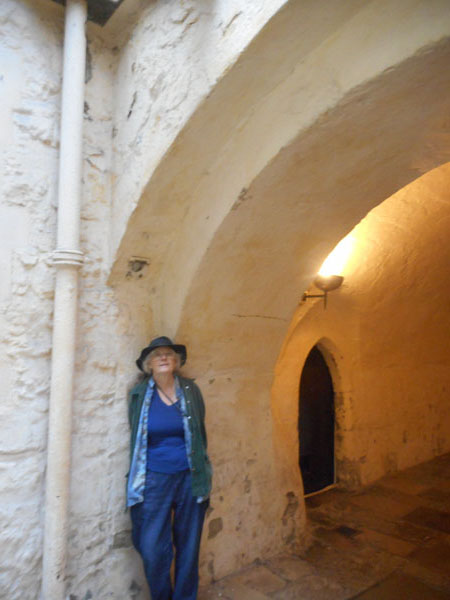 |
Next door are the buildings of Parliament, with the Elizabeth tower on the left (the bell is Big Ben, not the tower nor the clock). (the plane-spotters amongst you might notice the tilt-rotor Boeing Ospreys doing a fly-over... weird sounds) |
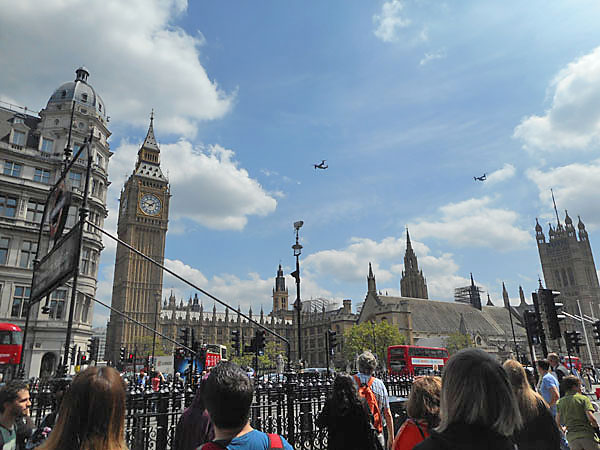 |
| ... and the Victoria tower on the right. |
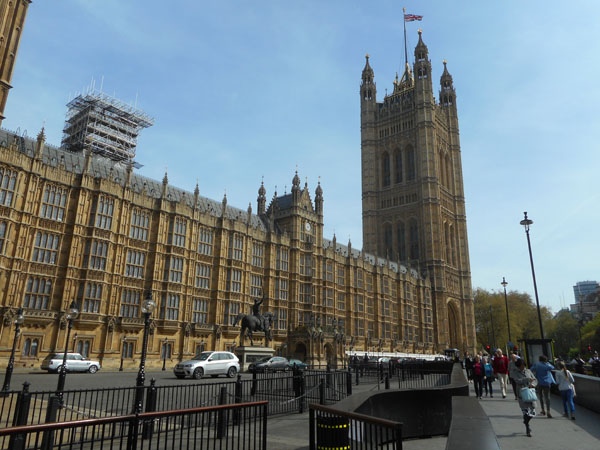 |
| To the south is the Thames but fenced off so you can't walk all the way along it like you can the Seine in Paris. The effect of high tide on walkway access might also be a problem. This is part of why we took the boat trip in part 2. |
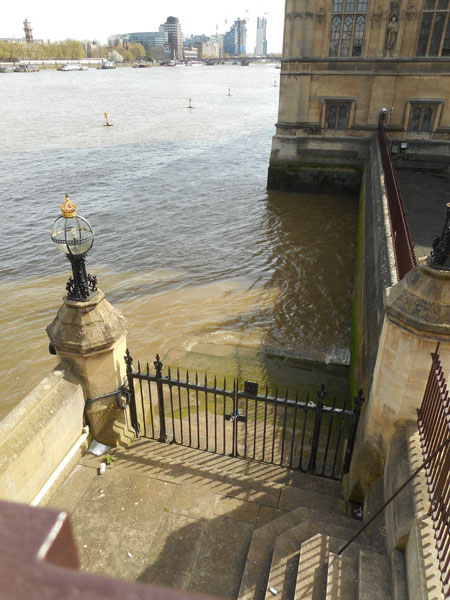 |
So we'll detour south around Parliament and Westminster Cathedral, which brings us to the Victoria Tower Gardens (somehow we managed to not take a photo of one of Rodin's "Burghers of Calais" groupings... it's the black object almost dead-center in the distance. You'll have to go to see it for yourselves.) |
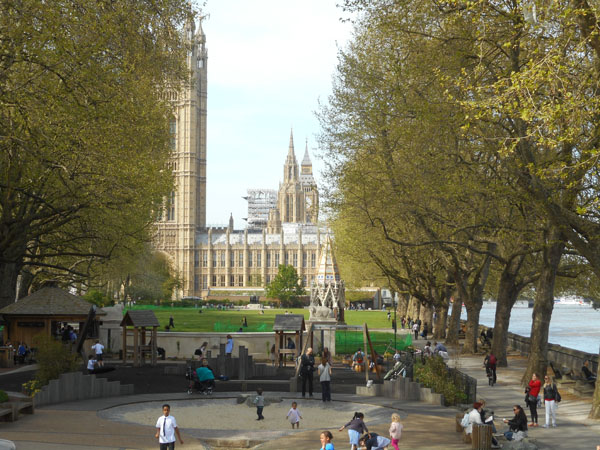 |
| with a play yard for children and this fun sculpture (pre-bridge this area was once called "horseferry", as the adjacent road still is). |
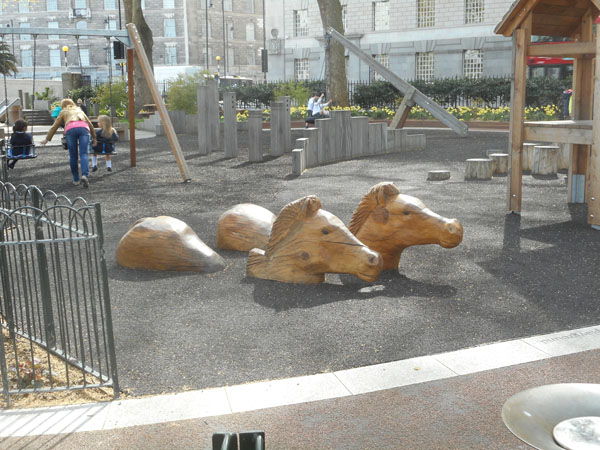 |
| This garden includes the Buxton Memorial which celebrates the abolition of slavery throughout the British Empire. Great to see more than just military victories celebrated. |
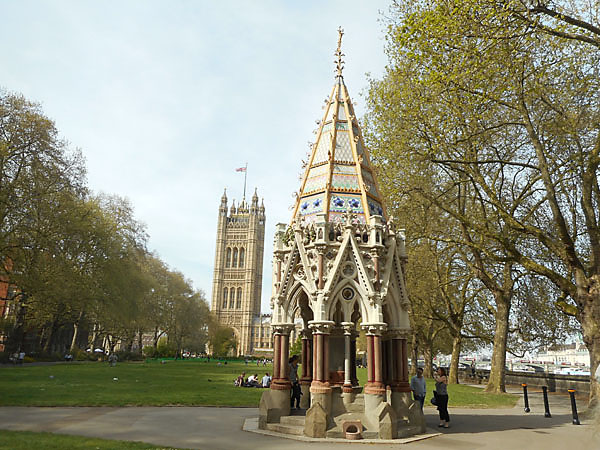 |
| The park had the usual pay-to-go: very clean and with TP (not always available, even after a turnstile). |
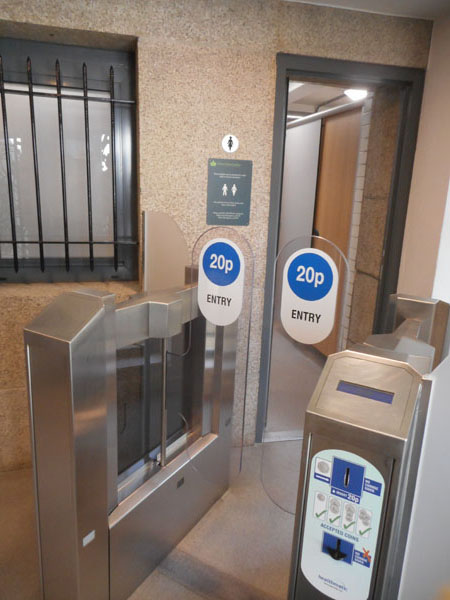 |
| Turning around and heading downriver (north, here) again, we pass Parliament and eventually reach the Whitehall Gardens, with three memorial statues. This one is General Sir James Outram, honored for his service in Persia and India. We admired its floral and be-palmed setting. |
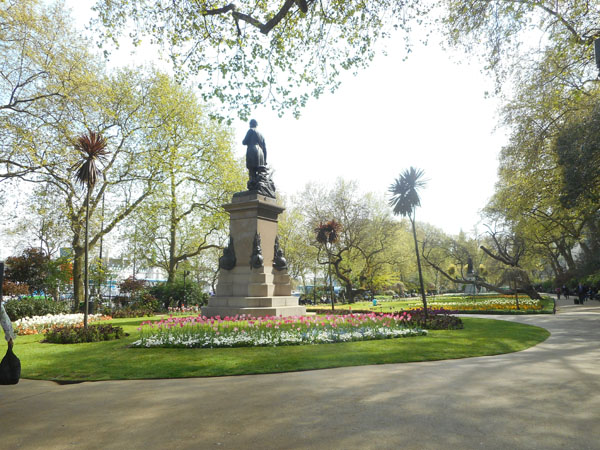 |
| Looking across the Thames, we're given a face-on view of the London Eye wheel, marking the South Bank neighborhood. |
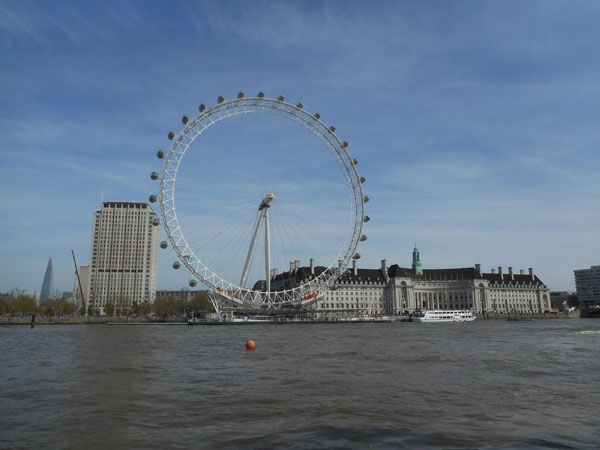 |
| But we stayed on the north bank, exploring the streets. We found they'd come up with new contrivances to place in empty ex-red telephone booths. |
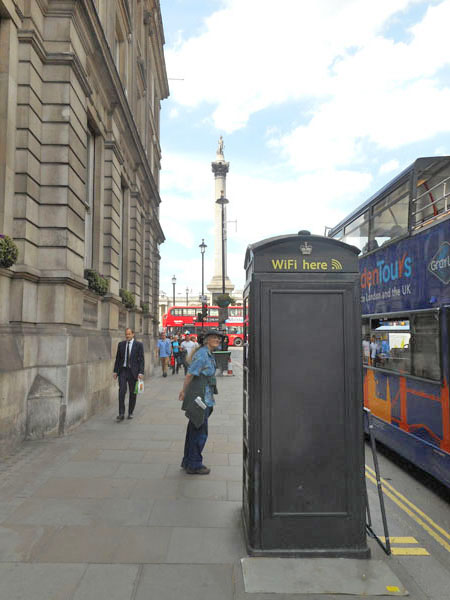 |
... old forms of transport
(we were passed once by a fully-caprisioned horse-drawn hearse) |
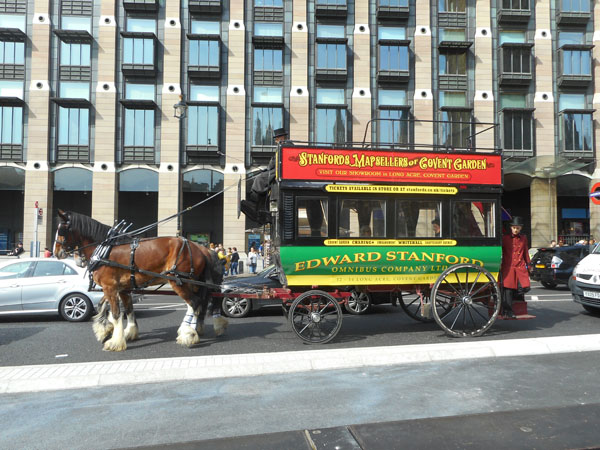 |
| ... and timeless ones. |
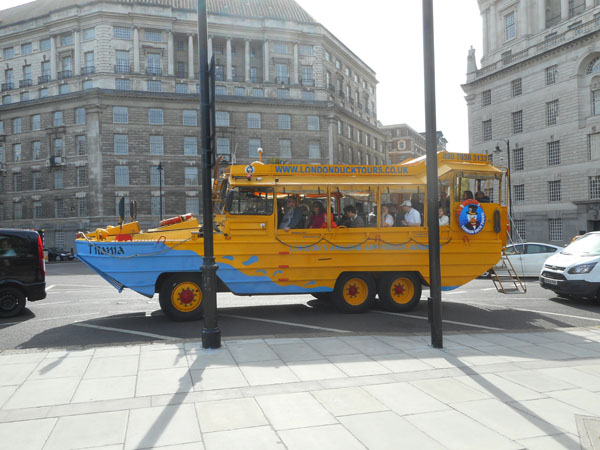 |
| Moving inland from our view of the Eye, we reached Nelson's Column standing before Trafalgar Square. |
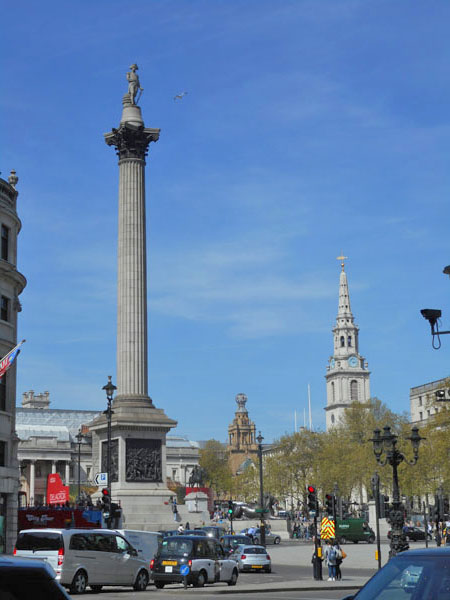
|
| Across the square is the National Gallery |
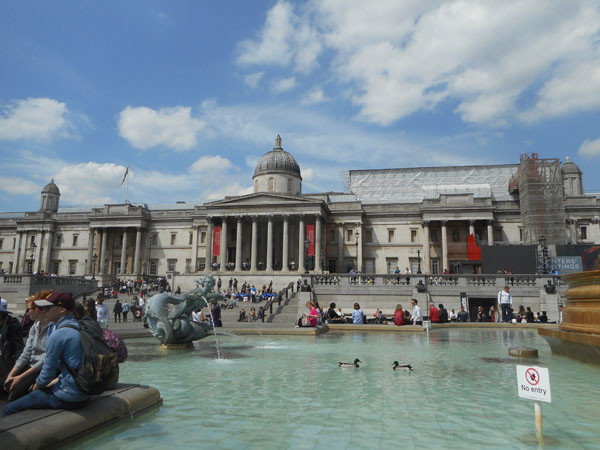 |
| The chaos of the square from the National Gallery's steps |
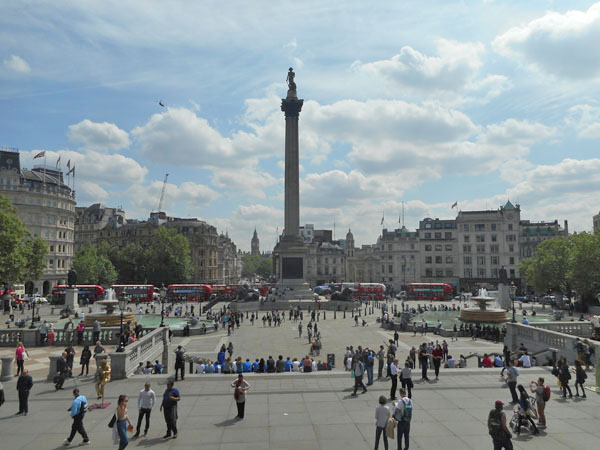 |
| The "statue" is sitting on a support that comes up through his sleeve and down his jacket to provide an invisible seat a few feet off the ground. |
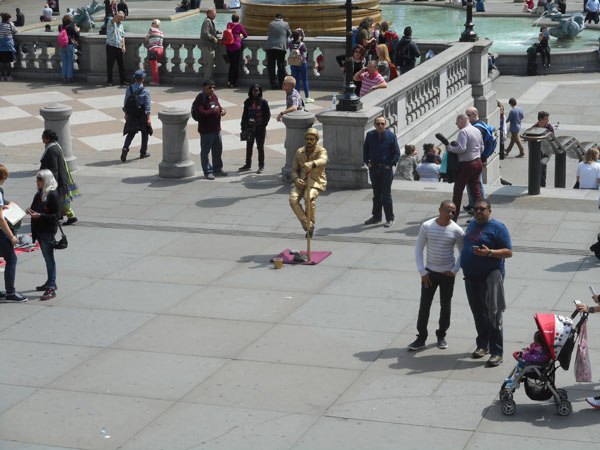 |
| Inside the National Gallery |
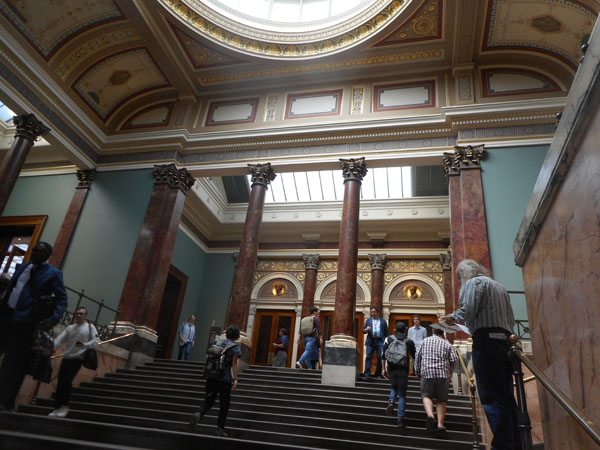 |
are the usual walls of paintings (Dick begins to suspect that one reason Karen likes the V&A so much is its relative lack of paintings...) |
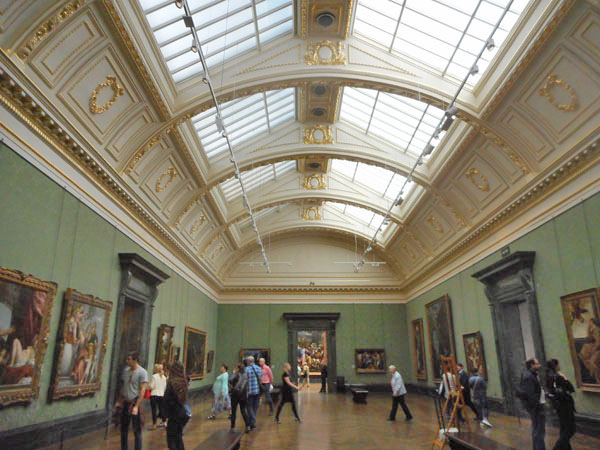 |
| But we were more impressed by the mosaics that were throughout the central mezzanine's flooring. |
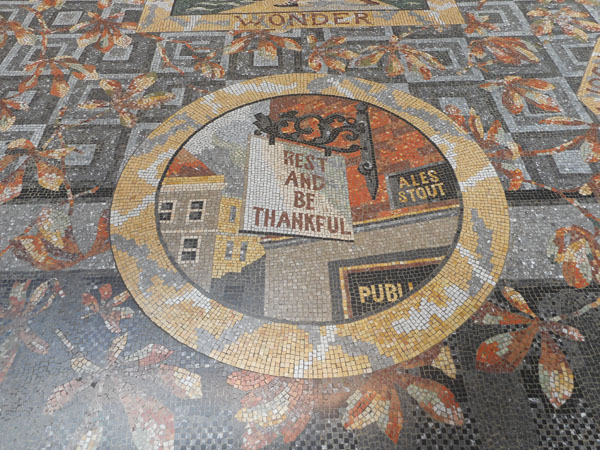 |
| |
 |
| |
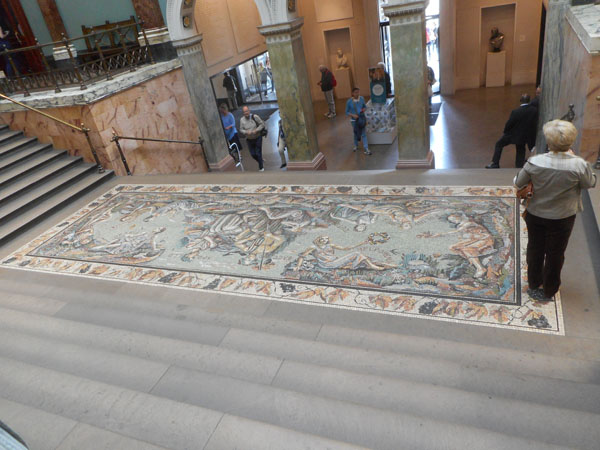 |
| Then we made our way back home past the Royal Horticultural Society building. It was even open for a few minutes more so we went in and looked at the small display of floral art and large number of books in the library (the RHS puts on the Chelsea Flower Show in part 6) |
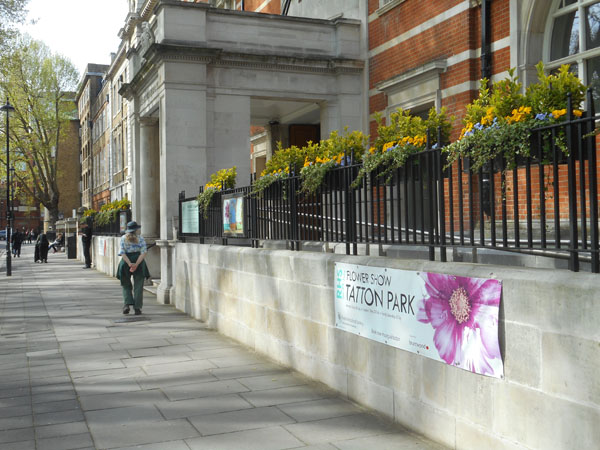 |
| A little further on took us to a side entrance of Victoria Station ... and we ducked in because we were hungry. |
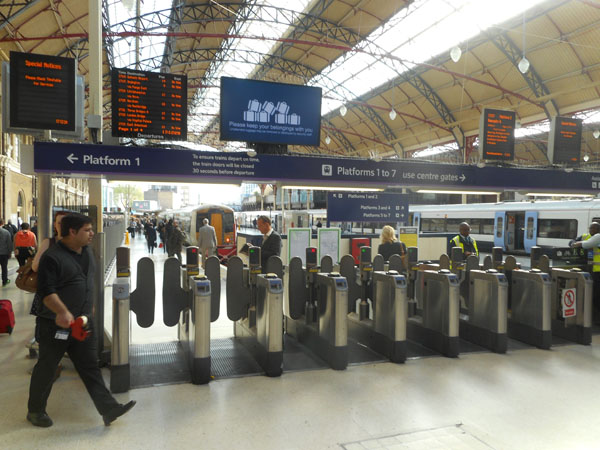 |
| First we tried the pasties ... but they all had potatoes, so Karen couldn't share Dick's enjoyment of one. |
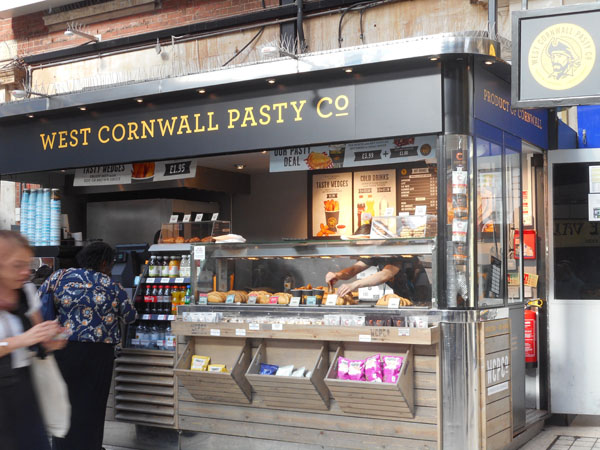 |
| ... so she visited the adjacent "door number two". |
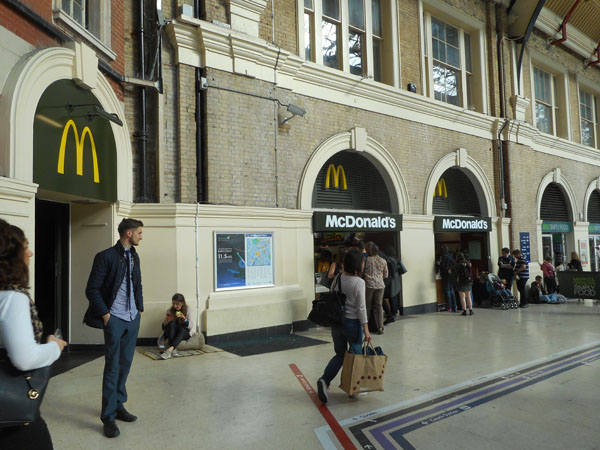 |





































































































